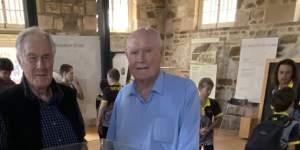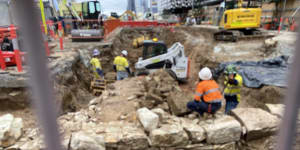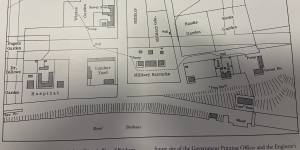Instead,they sit on a timber pallet. Somewhere.

Construction crews working on Brisbane City Council’s $1.4 billion Metro project discovered the dry-stone wall in October 2021,and it was.
The project’s archaeologist,Angus Crawford of Everick Heritage,said the 1830s-era convict-built wall was potentially the oldest dry-stone wall discovered anywhere in Queensland.
“You can see marks in the stone from the picks and chisels that would have been used to extract the stone,” he said.
But the Department of Environment and Science decided on February 11,2022,the 196-year-old stone wall was not worth preserving in situ or sending to the Queensland Museum.

Denver Beanland and Dean Prangley from the Royal Historical Society of Queensland say the unearthed convict-era wall would have been linked to Brisbane’s original hospital,shown in the front right of this model.Tony Moore
The department said the wall was removed by a bulldozer and archaeologists under a council plan set by Everick Heritage,which allowed for its off-site storage,analysis and conservation.
This masthead was told large sections of the wall had been dumped.
However,Brisbane City Council provided a photograph to show a portion of the wall remained.
Media were refused permission to view the wall to verify the photograph,which was taken in a yard owned by Brisbane Metro project builder Acciona.

A bulldozer breaking up and removing the remains under Adelaide Street.Tony Moore
No sections of the wall went to the Royal Historical Society of Queensland,either.
The society has a display of Brisbane’s earliest convict-era streets – including the wall’s exact location – in its William Street museum.
President Denver Beanland said neither they nor Queensland Museum staff had any idea where “one of Queensland’s most significant heritage finds” went after February 2022.
Beanland,a former state attorney-general,said the wall pieces should have gone to the Queensland Museum.
He said parts of the convict wall would also have made a significant addition to the society’s scale modelling of Brisbane’s earliest days.
“If it is part of the original construction of the buildings of that area – the old Lands Building,the old hospital buildings where the Supreme Court was – then yes,it would be a very significant loss to have it missing.”
Brisbane’s. When a new hospital was built at Herston in 1867,police moved into the original hospital. It was demolished in 1880.
A survey plan of Brisbane in 1840 by Robert Dixon clearly shows the 1827 convict hospital buildings on the lower left-hand side near North Quay.

Surveyor Robert Dixon’s plan of Brisbane in March 1840 shows the original hospital between what became North Quay and George Street.Royal Historical Society of Queensland.
According to Brisbane City Council,heritage officers in the Department of Environment did not require the foundations go to the Queensland Museum.
“The convict-era dry-stone wall was reported to the Department of Environment and Science and carefully removed under the guidance of a senior historical archaeologist,” a city hall spokeswoman said.
“The Department of Environment and Science do not require the materials to be preserved and catalogued at the Queensland Museum.”
The Environment Department said Brisbane council’s heritage plan for the Brisbane Metro project described how recovered archaeological material should be “catalogued,stored and curated in accordance with best practice guidelines”,before being “provided to a suitable agency that could ensure the material’s conservation”.
The Moreton Bay Penal Colony shifted from Redcliffe (1824) to Brisbane in May 1825,making the foundation walls part of Brisbane’s earliest days.
Get the inside word on the news,sport,food,people and places Brisbane is talking about..